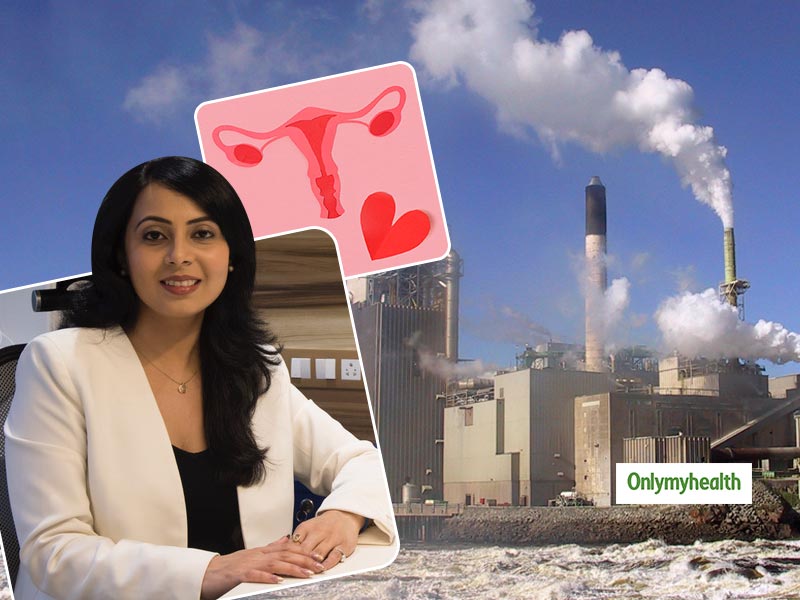
Reproductive health is intricately sensitive to characteristics of an individual's environment encompassing physical, biological, social, cultural and socioeconomic factors. One key influencer that women must progressively take into account is the environment and surroundings in which they thrive. Ecological elements like air pollution, dust, waste, pollutions, and emissions of harmful chemicals from the industry have been majorly associated with wrecking a women's capability to conceive and have a healthy pregnancy.
Table of Content:-
Air pollution hampering women’s reproductive health
- The growing urbanization in modern times has contributed to a strategic increase in the workplace and industrial pollution, as well as materials that are used commercially or in the residential areas.
- These are responsible for causing significant threats to an individual’s healthy living. Exposure to harmful substances like lead, for example, is related to fertility damages in both women and men, as well as with the jeopardy of spontaneous abortion and stillbirth; furthermore, being exposed to mercury in certain forms may lead to congenital disabilities and neural ailments.
- A host of solvents are responsible for spontaneous abortion rate and birth imperfections, and some of these constituents may be a factor in hypertensive illnesses during female gestation and male infertility.
- Poisonous chemicals and pesticides can also adversely impact one's reproductive wellbeing. The airborne pollutants encompass tiny bits of heavy metals, which might impede with the hormone systems that are essential for reproduction; contaminants also can change or disturb DNA and other hereditary material in sperm and eggs.
- The hazards associated with these pollutants also continue past the fruitful start of a pregnancy, as well—excessive contact to these pollutants has been to both higher rates of preterm birth and augmented chances of low birth weight as the concentration of pollutant upsurges.

Metal Exposure
- Being exposed to metals will escalate the danger of adverse birth outcomes.
- The exposure to heavy metals like cadmium, mercury and manganese causes increased risks of birth malformations and foetal growth restriction.
- Arsenic and lead indicate an increased occurrence of low birth weight and preterm birth.
Particle Pollution Is Unsafe for to-be mothers
Also Read: Do Babies Kick In Womb When Hungry? Know Why This Happens!
- Particle pollution, a mixture of harmful particles both solid and liquid that drift around in the air, is one of the leading causes hampering one's reproductive health and can also lead to various illnesses.
- Although this can shower its adverse impacts on any individual, an expecting mother and her baby can often be hit the hardest. This contaminated particulate matter leads to irritation in the lungs, eyes, and throat, making it problematic to breathe.
- While it is possible to cough and sneeze the larger particles out of the body, the smaller particles tend to get stuck in the lungs and slowly make their way to the bloodstream.
Being exposed to chemicals and human-made compounds

- The direct contact with possibly destructive chemicals is another increasingly common health concern in the contemporary world, chiefly for women who are trying their best to conceive or are presently expecting.
- Carbon-based contaminants and endocrine-disrupting chemicals present in the environment harm both male and female fertility.
- These human-made compounds are present in materials such as metals, pesticides, food seasonings, and personal care products.
- Both human-made and naturally occurring constituents that appear to hamper with hormone synthesis or action are among substances whose impacts on reproductive health are strongly advocated.
Also Read: Is It Safe To Take Magnesium When Pregnant?
How to Curtail Environmental Risks
- Luckily, the effects of many environmental hazards can be mitigated or even evaded totally. Thanks to augmented mindfulness on the impact of various health ailments and psychoactive materials, mothers-to-be are now able to safeguard a healthy living that is free from detrimental substances by the time they conceive a baby.
- While conservational menaces pose a definite threat to the developing foetus, they do not always cause impairment. The impact of such hazards comprises the communication of several issues, including the timing of the exposure, the period of the disclosure, and likely hereditary susceptibilities that may be present.
- Along with paying proper attention in minimizing the dangers associated with these environmental toxins, proper prenatal care is equally important to sustain a healthy pregnancy.
(Inputs by Dr Anagha Karkhanis - Senior Gynaecologist and Infertility Specialist and Director of Cocoon Fertility)
Read more on Women's Health
How we keep this article up to date:
We work with experts and keep a close eye on the latest in health and wellness. Whenever there is a new research or helpful information, we update our articles with accurate and useful advice.
Current Version